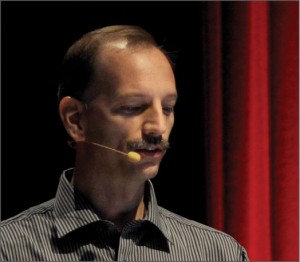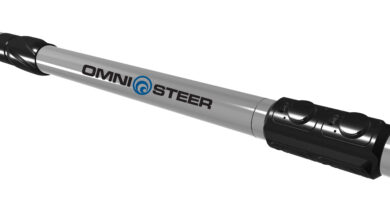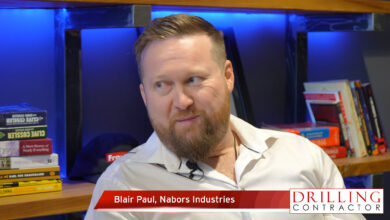Drilling automation: Is resistance futile?
Apache automation advisor believes barriers are few and time is ripe, but operators must drive business-model change
By Linda Hsieh, managing editor
“Automation”: Say the word the right way with the right group of people in drilling circles, and it can almost come off as an obscenity. Drilling is an art, they say, with too many unpredictabilities. How can it be entrusted in the hands of a bunch of machines, computers and algorithms?
Whether drilling is an art is arguable, but what’s undeniable is that we live in an age where computers, not pilots, safely fly airplanes carrying millions of passengers around the world each year. Is it really absurd to suggest that one day we may be able to automate the drilling process so that different pieces of rig equipment not only talk to each other, but to all the different pieces of downhole equipment, sharing and feeding each other real-time well data and information in a continuous loop that optimizes itself?

If you ask Jim Rogers, automation advisor, worldwide drilling for Apache Corp, the answer is no, it’s not absurd. In fact, he’s wondering why we’re not doing it already. As an automation professional certified by the International Society of Automation with more than two decades of experience implementing automation solutions in industries such as chemical, oil and gas, utility, power generation and general processing, Mr Rogers has seen the challenges that our industry is facing many times over. To him, we’re not that different; we just perceive ourselves to be different. And most of the barriers we think are insurmountable can either be easily overcome or aren’t even there, he says.
Skeptical? Many in the industry are. But seeing is believing, and that’s why innovative oil companies such as Apache are funding demonstration projects to prove that true automated drilling can be achieved with today’s technologies.
Before Apache, Mr Rogers spent six years with Shell, where he designed and implemented automation controls and worked on projects demonstrating the capability of remote directional drilling systems. Now at Apache, he is working on further demonstration projects where a SCADA (supervisory control and data acquisition) system has been installed on a rig to coordinate the functions and controls of the different pieces of equipment, and algorithms are being run to make decisions that a driller would normally make. The team plans to drill continuously for the rest of this year and likely into next year, currently with one rig and perhaps adding a second rig in the fall.
Mr Rogers recently spoke with Drilling Contractor about the future of drilling automation, the perceived and actual barriers, why automation is necessary and the coming and perhaps painful business model change associated with the transition.
Drilling Contractor (DC): Is the drilling industry really so different from other industries that we can’t take proven automation technologies and apply them here safely and efficiently?
Rogers: That’s a common perception, but it’s not true. Drilling is different, but I still say you can define it. And if you can define it and measure it, you can control it. You can apply techniques from other industries to solve your challenges.
DC: So how is drilling different?
Rogers: In a refinery, in an automobile manufacturing plant, or in a chemical plant, you have one owner. Suppliers bring their equipment in and it stays there, and nothing changes after that. You have a known process that gets repeated on the same equipment.
Drilling’s not that way. In drilling, you have people coming and going. You have equipment suppliers delivering their equipment on this well, but on the next well it might be someone different. That’s true, but that’s not a technical barrier. It’s a cultural barrier. There are cultural barriers and emotional barriers. There are no technical barriers. You can add and remove equipment and still automate it.
Each well might be in a different lithology, and the reservoir might be different, but that’s OK because we know how to drill in those reservoirs. With the wells that are being drilled today, you can’t convince me that there are brand-new problems that nobody has ever seen before in drilling through a layer of rock. Every layer of rock we’re drilling through, we’ve already drilled through before, and the problems we’re seeing are the same problems we’ve seen before.
All industries have unique problems. Sure, some of drilling’s challenges and issues are a little bit different, but many of them are common to other industries. Don’t focus on the different ones, focus on the common ones and let’s make some progress.
DC: What specific automation technologies can we implement in our industry now that have already been proven in other industries?
Rogers: Supervisory control. The drilling industry is comparable to where automobile manufacturing was in the early 1980s. General Motors was looking around their manufacturing plant and saw what they called “islands of automation.” You had a worker in his work cell with his equipment. Materials would come into his cell, he would work on them, and he would send the materials out. And they would get bottlenecks of flow of materials through their factory because this worker worked in complete isolation of everybody else. Just like you have in well construction.
This was a problem for GM because they couldn’t make their operations more efficient. They saw a need to connect these “islands of automation.” To do that, they started defining standards for communication protocols and equipment. These standards would then allow the systems and the work flows to be connected together. Then you could start doing resource planning using automation and standards and communications.

DC: Getting all the various pieces of drilling surface and downhole equipment to talk to one another doesn’t sound like an easy task.
Rogers: That’s another common perception, and it’s an awareness issue. It’s not hard to get the equipment to talk together. When we did a demonstration project in Canada in 2009 (with Shell), the well delivery team held a meeting with the drilling contractor and service providers. Everybody advised me that my plans of trying to hook this equipment together would be really hard and their experience was it would take somewhere between four to six months to try to get it working and get the bugs worked out and get it stable. We did it in two and a half days.
This is hard if you want to start from a blank sheet of paper, but I used commercial off-the-shelf (COTS) products. Commercial off-the-shelf products are there, and they’re cheap. Within a couple of days, we had umanned MWD talking to our control system, we had the rig talking to the control system, and we had the mud pumps talking to the control system.
None of this is hard. People just need to be shown how to do it, and that’s where these demonstration projects come in. That’s what we were doing at Shell, and that’s what we’re doing at Apache.
DC: What are you trying to achieve with the current demo project at Apache?
Rogers: Right now we have one rig drilling in the Permian Basin in West Texas, and we want to expand upon what was done with the early projects with Shell. Those early projects focused on directional control. Now we want to take the bigger-picture view and look at all the components of well making and integrate all the components, not just the drilling, but pipe handling, cementing, fracking operations, and even well planning. The idea is to integrate the work flows, from the time you plan the well and drill the well on paper, to the time you actually drill the well and complete the well. All those activities should be an integrated work flow.
We’ve hooked up the different pieces of equipment together into a common aggregator, and we’re collecting all the data sources and putting them into a single spot. Now we have enough information to start sending control responses back to those pieces of equipment.
Essentially we coordinate the operations of the equipment and the work flows. Mud pumps are coordinated with the top drive, which is coordinated with the drawworks, which is coordinated with the pipe handling, which is coordinated with the downhole RSS directional steering and MWD and LWD. We hook all these systems together and have coordinated control. Normally what controls all of this is the driller. We now have a computer do that instead of the driller.
DC: Some in the industry would have strong objections to having a computer be in control instead of the driller. How do you respond to claims that drilling is an art that needs human analysis?
Rogers: Drilling is a procedure, and procedures can be described. How did drillers learn to drill? They were put in a chair, and somebody told them to do this or don’t do this. They call it an art, but it’s more a learning or an experience. A driller, over time, learns how to drill. He learns what the issues are and how to react to them. But each new driller has to re-learn that same stuff over and over.
When a driller sees overpull increase and he knows the pipe might get stuck because the hole isn’t clean and he needs to stop drilling and clean the hole, that’s something he recognizes based on his experience. If he can recognize it and respond to it, then a program can be taught to do the same thing.
You have drillers coming in with each new generation re-learning the same things that the generation before them already learned. We are not finding brand-new problems that nobody’s ever seen before. We’re finding brand-new drillers that haven’t seen old problems before. All we have to do is capture those learnings. That’s the process narrative.
In process industries, they capture the best learnings of the best operators and put that into their computer automation programs. They’ve done that successfully for years. We can do that too.
DC: You mentioned that the industry doesn’t have to start from scratch if we want to achieve this kind of automation. What kinds of automation technologies are out there and available for our use?
Rogers: It’s not just technologies; there are standards. There are hundreds of standards on everything from instrumentation to process safety to human factors engineering to equipment specifications. In communications, there are standard communications protocols that equipment can use to communicate to pass data. It’s already done. We just have to use them.
But when you ask people in the drilling industry about standards, they’re not really aware of them because they haven’t been adopted or put into practice. It’s just a matter of awareness, adoption and implementation.

DC: So if this is all possible on a technical level, on the flip side, is there really a business case for doing all this?
Rogers: Yes. The “easy oil” is diminishing, which means the cost of extracting hydrocarbons is going up. We have to find ways to reduce that cost, and we have to find step-change ways of doing that. We’re not looking for just incremental changes. Instead of 16 days on a well, let’s go to 10 days or even less. You can’t do that with incremental changes. You have to do something fundamentally different, and that is going to cause a business-model change. There is no way around it. People have to do things differently than they’re doing it now.
DC: But the business model is different for operators and for drilling contractors and service providers.
Rogers: It’s very different. The business model is mostly driven by the operator. For contractors and service companies, their business model has traditionally been centered around a dayrate service. They don’t have much of a motivation to change, but they will have to.
I compare this to what happened in the process automation industry in the 1990s. Companies that made control systems used to do the circuit board design, circuit board manufacturing and made their own entirely proprietary systems. But when the personal computer and workstation industry became commoditized in the 1990s, in order to become competitive, control systems makers started incorporating Hewlett Packards, Dells and Gateways into their product lines. That caused a business-model change. Everybody started looking alike because every control system maker was using some off-the-shelf computer.
To differentiate themselves, they concluded that it came down to their knowledge of their customers’ business and understanding of his issues. Therefore, people became very important. Their process knowledge became very important because that gave them better products to solve the problems, so they became partners with their customer base. The value-add came in problem-solving rather than commodity products.
The point of the story is that they had to go through a business transformation if they wanted to stay in business. It was painful, but it was a necessary pain. It was a business change that was thrust upon them, but if you approached it with the right attitude, it was an opportunity to grow the business.
That’s what I see is what will have to happen in the drilling industry. Service providers and drilling contractors will have to adjust their business model. How they view it will determine how successful they will be. There were companies in the process control industry that struggled against this change, and they saw double-digit market shares go down to single digits.
I see that coming in this industry too. You have the early adopters, and you have those who are resisting change. Market shares will shift depending on who is going to be innovative and find ways to adapt to the business-model change and who’s not.
DC: It seems like it is going to be up to the operators to drive this business-model change, rather than the drilling contractors or service providers.
Rogers: Definitely. The operator should take the lead role in bringing change to the way we do things because ultimately the operator is responsible for what gets done on the lease. However, it has to be in a partnership with the suppliers. You need suppliers that will work with you in finding this innovation and finding these step-changes.
The key is you have to be willing to try something different, and there’s resistance to that. It’s a cultural barrier. People don’t want the risk of trying something new, especially a drilling contractor or service company. They don’t want the risk because they’re judged on a dayrate and not causing a problem, which means they’re very conservative. They believe that if they take a conservative approach that they won’t have problems, so that’s what they’ll do everytime.
DC: Based on your experience with other industries, do you see a much higher resistance to risk in the drilling industry compared with other businesses that’s hindering our adoption of automation technologies?
Rogers: Absolutely not. None of this is really new. It’s not surprising. I’ve seen this happen in a number of different industries and I’ve seen different industries go through their challenges and go through their business-model changes. They’ve done it, and now it’s drilling’s turn.
DC editor and publisher Mike Killalea talks to Jim Rogers, automation advisor, worldwide drilling for Apache, about the challenges of realizing true drilling automation.





having watched Aker MH spend months try to get the “modern” roughneck machines to corretly go to well centre and stab inn a piece of pipe (without that much sucsess) i dont have to much optimism in automation.. there is to much “what about” lurking around.
What about bha’s.. one configuration going inn… different coming out… or maybe not comming out at all. Bendt pipe, stuck pipe, broken pipe… i could go on and on…
.. and then we could start talking about soleniod valves, how’s the automation going to act on an moody soleniod valve?
Excellent article.
In our rapidly expanding industry, there are a number of key factors increasing risk including the ‘Great Crew Change’ and a shortage of competence as international operators and contractors accelerate the development of fresh talent.
Automation will help reduce/eliminate risk by managing the human factors that can lead to delays/misinformation associated with detecting and solving unwanted situations.
Jonny Macklin
jonny.macklin@sekal.com